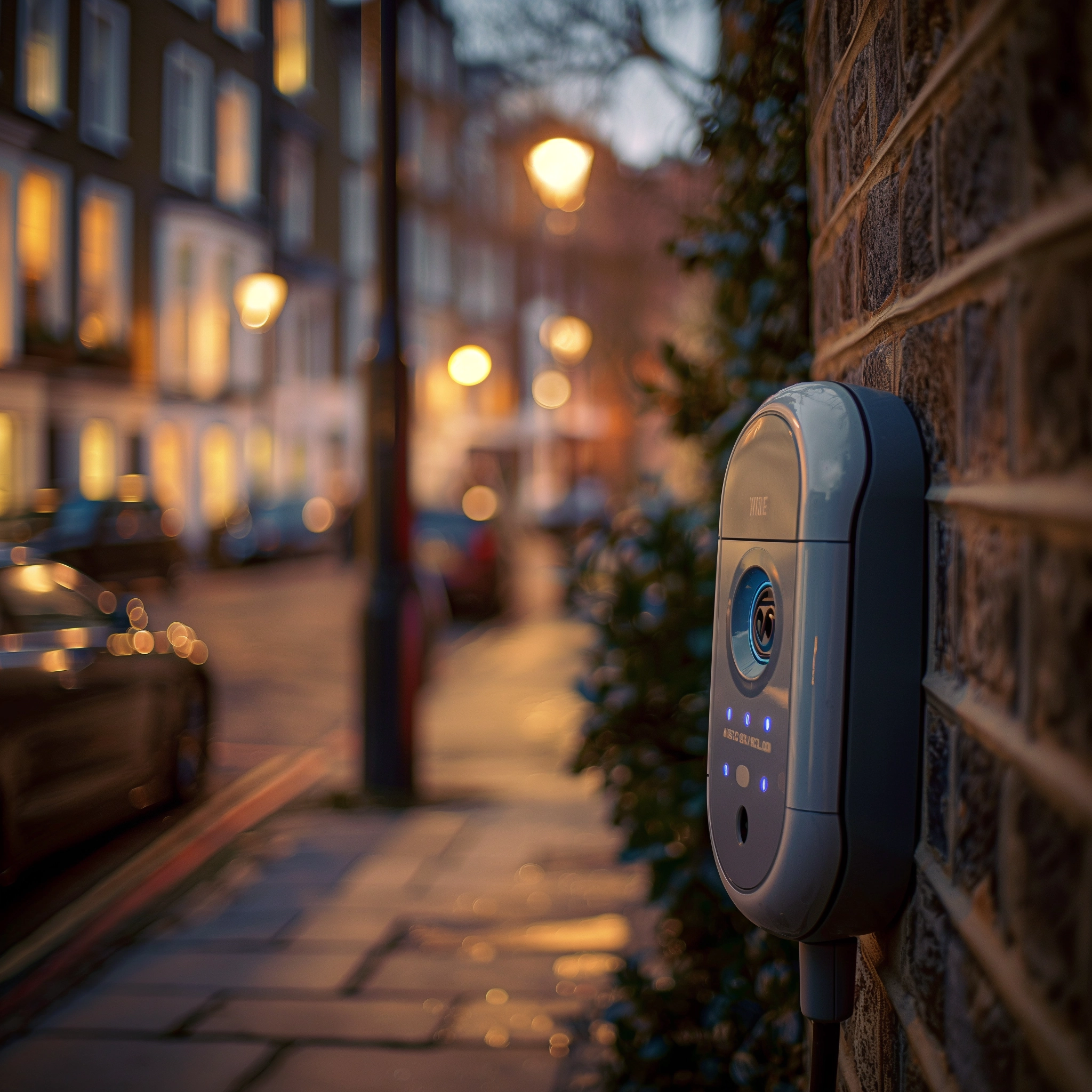With the UK’s ambitious 2030 deadline to ban the sale of new petrol and diesel cars fast approaching, the spotlight is increasingly on the adoption of electric vehicles (EVs) as a crucial pivot towards sustainable transport. The transformation of the country’s vehicle landscape hinges not just on the availability of EVs but equally on the infrastructure that supports them.
A key component of this infrastructure is the home charging station, an essential for EV owners looking to ensure their vehicles are charged and ready to go. This article delves into the essentials of installing a home charging station in the UK, providing a comprehensive guide for homeowners looking to make the switch to electric.
Government Incentives and Regulations
A significant boost to the home charging infrastructure comes in the form of the Electric Vehicle Homecharge Scheme (EVHS), which offers up to £350 towards the cost of installing a home charge point. This scheme is pivotal for homeowners with off-street parking, driving forward the government’s agenda by making EV ownership more accessible and convenient.
The EVHS is targeted at fully electric vehicles and plug-in hybrids, with specific models of charge points pre-approved for installation. It’s essential for homeowners to understand the eligibility criteria and the process to claim this grant, which involves the appointed installer submitting necessary documentation on behalf of the homeowner to the Department for Transport.
The Rise of Smart Charging Solutions

Among the various products available on the market, SMA EV Chargers have emerged as a frontrunner, thanks to their endorsement by the Office for Zero Emission Vehicles (OZEV). These chargers are notable for their integration capabilities with photovoltaic (PV) systems, allowing homeowners to harness solar energy for vehicle charging.
This not only optimises energy usage but also contributes to a lower carbon footprint. SMA chargers are versatile and compatible with standard EVs using a Type 2 charging cable, the most common connection in Europe. The selection of a charger is a critical decision for homeowners, involving considerations of charging speed, tethered versus universal models, and the potential need for future upgrades.
Installation Process and Considerations
The installation of a home charging station is a multifaceted process that begins with an assessment of the electrical capacity of the home and the available space for the charger. Legal and safety standards are paramount, with installers required to ensure that the setup complies with all regulations, including the British Standard BS7671. Smart chargers, which require internet connectivity, add an additional layer of complexity, offering advanced features such as scheduling and tracking energy usage but necessitating a stable Wi-Fi connection.
Professional installation is not merely a recommendation; it is a requirement to meet safety standards and to qualify for government grants. The process encompasses a feasibility analysis, detailed assessment, and the physical installation of the unit, followed by thorough testing to ensure everything is operating as it should be. Installers also need to notify the District Network Operator (DNO) about the new installation, a step that underscores the importance of integrating home charging stations into the wider electrical grid without compromising its integrity.
Post-Installation: Maintenance and Upgrades
After the installation, homeowners are advised to consider the long-term aspects of their charging station, including maintenance and the potential for future upgrades. While SMA chargers boast high efficiency and a low failure rate, it’s prudent for homeowners to be prepared for any necessary repairs. Additionally, technological advancements may necessitate upgrades to existing equipment, so selecting a charger with a basic package that allows for easy upgrades can be beneficial.
Practical Considerations and Benefits
Choosing the right charger involves weighing the merits of standard speed (7kW) versus high-speed (22kW) chargers, the latter offering faster charging times at a higher installation cost. The location of the charger in relation to the parking space and Wi-Fi signal strength is another crucial factor, as it can affect the functionality of smart features. Beyond the technical aspects, the benefits of home charging stations are clear: they offer unparalleled convenience, potential cost savings on fuel, and contribute to reducing the environmental impact of personal transport.
Selecting the Right Location for Installation

The decision on where to install a home charging station within one’s property is not just a matter of convenience but also of safety and efficiency. The proximity to the main electrical panel can affect installation costs, as longer distances may require additional wiring and labour. Furthermore, for homeowners looking to utilise smart chargers, the strength of the Wi-Fi signal at the installation site is crucial for accessing all the functionalities offered by the device. Ideally, the charging station should be positioned close to where the EV is parked to minimise the need for extension cables, which can be a trip hazard and potentially reduce charging efficiency.
Integration with Renewable Energy Sources
One of the most compelling aspects of installing a home charging station is the opportunity to integrate it with renewable energy sources, such as solar panels. SMA EV Chargers, for example, are designed to work seamlessly with photovoltaic (PV) systems, allowing homeowners to charge their vehicles using solar energy generated on-site.
This not only reduces the environmental footprint of charging an EV but can also offer additional savings on electricity bills. By charging during daylight hours when solar production is at its peak, homeowners can maximise the use of renewable energy and minimise reliance on the grid, embodying a truly sustainable lifestyle.
Legal and Safety Standards
Compliance with legal and safety standards is paramount in the installation process. The electrical installation must meet the British Standard BS7671, and specific protections, such as earth rods and PEN (Protective Earth Neutral) fault protection, may be required depending on the setup. These standards ensure the safety of the household and the reliability of the charging station. Professional installers are well-versed in these requirements and can guide homeowners through the necessary steps to achieve compliance, including notifying the District Network Operator (DNO) about the new installation.
User Experience and the Advantages of Home Charging
The user experience of owning an EV is significantly enhanced with the installation of a home charging station. This setup provides EV owners with the utmost convenience, allowing for charging overnight or at times when electricity rates are lower, thanks to time-of-use tariffs. This not only ensures that the vehicle is always ready for use but also optimises charging costs.
Moreover, the ability to manage charging sessions through smart technology enhances this experience, giving owners control over their vehicle’s charging schedule and enabling them to monitor energy consumption and costs in real time. These aspects of home charging contribute to a seamless, efficient, and user-friendly EV ownership experience.
Environmental Benefits and the Path to Zero Emissions

The environmental benefits of transitioning to EVs and installing home charging stations are profound. By reducing reliance on fossil fuels, EVs contribute to lower greenhouse gas emissions, improving air quality, and fighting climate change. When paired with renewable energy sources, such as solar or wind power, the environmental impact of charging an EV diminishes further, moving society closer to a zero-emissions future. This synergy between EVs, home charging stations, and renewable energy sources underscores the potential for individual actions, such as choosing to drive an EV, to have a significant collective impact on environmental sustainability.
Looking Forward: The Future of Transportation
The journey towards widespread EV adoption and the normalisation of home charging stations is indicative of a broader shift in societal values towards sustainability and environmental responsibility. As technology continues to advance and the infrastructure supporting EVs becomes more integrated into our daily lives, the vision of a sustainable transportation system seems increasingly attainable. We stand at the cusp of a new era in transportation, one where electric vehicles play a central role in shaping a cleaner, more sustainable future for all.









































